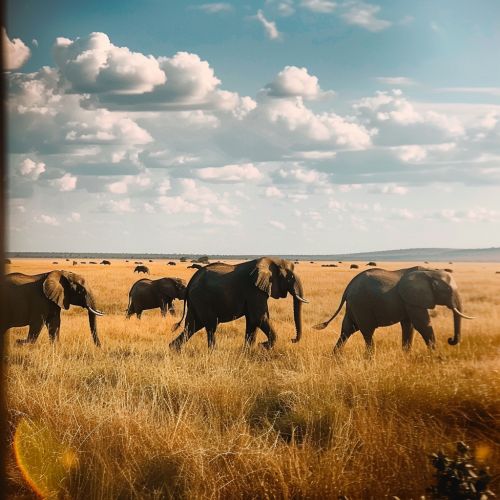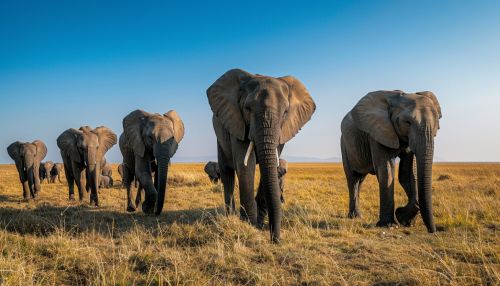Social Structure in Animals
Introduction
Social structure in animals refers to the complex organization of individuals within a species that dictates their interactions, roles, and hierarchies. This structure is influenced by various factors including genetics, environment, and evolutionary pressures. Understanding animal social structures provides insights into their behavior, survival strategies, and evolutionary adaptations.
Types of Social Structures
Solitary
Some animals, such as tigers and leopards, lead solitary lives, coming together only for mating. Solitary animals often have large territories and exhibit behaviors aimed at avoiding others of their kind.
Pair Bonds
Certain species form pair bonds, where two individuals, typically a male and a female, form a long-term partnership. This is common in many bird species, such as bald eagles and albatrosses, where both parents participate in raising offspring.
Family Groups
Family groups consist of parents and their offspring. This structure is seen in many mammalian species, including elephants and wolves. These groups often exhibit cooperative behaviors such as hunting and caregiving.
Matriarchal Societies
In matriarchal societies, females hold the dominant positions. Elephants are a prime example, where the oldest female leads the herd. This structure ensures the transfer of knowledge and survival skills across generations.
Patriarchal Societies
Patriarchal societies are dominated by males. Gorillas exhibit this structure, where a single dominant male, known as a silverback, leads the group and has exclusive breeding rights.
Eusociality
Eusociality is the highest level of social organization and is characterized by cooperative brood care, overlapping generations, and division of labor. This is seen in honeybees, ants, and termites. In these societies, individuals are divided into castes with specific roles such as workers, soldiers, and reproductive individuals.
Factors Influencing Social Structure
Genetics
Genetics play a crucial role in determining social structures. For example, the genetic makeup of honeybees dictates their roles within the hive. The queen bee's pheromones influence the behavior and development of other bees.
Environment
Environmental factors such as resource availability, habitat type, and predation pressure significantly influence social structures. Meerkats in arid environments form cooperative groups to enhance survival through shared vigilance and foraging.
Evolutionary Pressures
Evolutionary pressures shape social structures to optimize survival and reproductive success. For instance, the cooperative hunting strategies of wolves and lions increase their efficiency in capturing prey.
Communication and Social Interactions
Vocalizations
Many animals use vocalizations to communicate within their social structures. Dolphins employ a complex system of clicks and whistles to convey information and maintain group cohesion.
Chemical Signals
Chemical signals, or pheromones, are used extensively in social insects like ants to coordinate activities and establish hierarchies. These signals can indicate reproductive status, territory boundaries, and alarm cues.
Visual Signals
Visual signals, such as body postures and facial expressions, are crucial in species like chimpanzees and wolves. These signals help to establish dominance, submission, and social bonds.
Tactile Communication
Tactile communication involves physical contact and is essential in species like primates and elephants. Grooming behaviors in primates strengthen social bonds and reduce tension within the group.
Hierarchies and Dominance
Linear Hierarchies
Linear hierarchies are common in many social animals, where individuals are ranked in a linear order. Chickens, for example, establish a pecking order that dictates access to resources and mating opportunities.
Despotic Hierarchies
In despotic hierarchies, a single individual holds dominance over all others. This is seen in species like gorillas, where the silverback male exerts control over the group.
Complex Hierarchies
Complex hierarchies involve multiple levels of dominance and subordination. Spotted hyenas exhibit such structures, with females typically holding higher ranks than males.
Cooperation and Altruism
Cooperative Breeding
Cooperative breeding involves individuals other than the parents assisting in raising offspring. Meerkats and African wild dogs exhibit this behavior, enhancing the survival of the young through shared responsibilities.
Altruistic Behaviors
Altruistic behaviors, where individuals perform actions that benefit others at a cost to themselves, are observed in species like vampire bats. These bats share blood meals with roost-mates that have failed to feed, ensuring group survival.
Reciprocal Altruism
Reciprocal altruism involves the exchange of beneficial acts between individuals over time. Primates often engage in grooming and food sharing, fostering long-term social bonds and cooperation.
Social Learning and Culture
Social Learning
Social learning, where individuals acquire behaviors through observation and imitation, is prevalent in species like chimpanzees and dolphins. This learning method allows for the transmission of knowledge and skills across generations.
Culture
Culture in animals refers to the shared behaviors and practices within a group that are passed down through social learning. Orcas exhibit distinct hunting techniques and vocalizations that vary between pods, indicating cultural differences.
Conflict and Resolution
Aggression
Aggression is a common aspect of social interactions, used to establish dominance and defend resources. Lions and wolves engage in aggressive displays and fights to maintain their social hierarchies.
Reconciliation
Reconciliation behaviors, such as grooming and affiliative gestures, are observed in species like bonobos and chimpanzees. These behaviors help to repair social bonds and reduce tension after conflicts.
Avoidance
Avoidance strategies are employed by subordinate individuals to prevent conflicts with dominant ones. Deer and antelopes often use subtle body language to signal submission and avoid aggressive encounters.
Social Structures in Different Species
Mammals
Mammalian social structures vary widely, from solitary tigers to highly organized elephant herds. The complexity of these structures is influenced by factors such as reproductive strategies, parental care, and resource distribution.
Birds
Birds exhibit diverse social structures, including monogamous pair bonds, cooperative breeding, and colonial nesting. Penguins form large colonies for breeding and protection, while crows exhibit complex social interactions and problem-solving abilities.
Insects
Insects like ants, bees, and termites have highly organized eusocial structures with distinct castes and division of labor. These structures are essential for the efficiency and survival of the colony.
Marine Animals
Marine animals such as dolphins, whales, and octopuses display intricate social behaviors and communication methods. Dolphins form pods with strong social bonds, while octopuses exhibit solitary and complex problem-solving behaviors.
Evolution of Social Structures
Natural Selection
Natural selection drives the evolution of social structures by favoring behaviors that enhance survival and reproductive success. Cooperative hunting, for example, increases the chances of capturing prey and providing for offspring.
Kin Selection
Kin selection explains the evolution of altruistic behaviors that benefit relatives. Honeybees exhibit extreme altruism, with workers sacrificing their lives to protect the hive and ensure the queen's reproductive success.
Sexual Selection
Sexual selection influences social structures through mate choice and competition. In species like peacocks, males display elaborate plumage to attract females, leading to complex mating behaviors and hierarchies.
Human Impact on Animal Social Structures
Habitat Destruction
Human activities such as deforestation and urbanization disrupt animal social structures by fragmenting habitats and reducing resources. Orangutans and tigers are particularly affected by habitat loss.
Climate Change
Climate change alters environmental conditions, affecting the availability of food and water. This impacts social structures, as seen in polar bears, whose hunting grounds are diminishing due to melting ice.
Conservation Efforts
Conservation efforts aim to preserve and restore animal social structures by protecting habitats and implementing breeding programs. Wolves have been successfully reintroduced into areas where they were previously extirpated, restoring their social dynamics.
Conclusion
Understanding social structure in animals provides valuable insights into their behavior, ecology, and evolution. These structures are shaped by a complex interplay of genetic, environmental, and evolutionary factors. By studying animal social structures, we can better appreciate the diversity of life and the intricate relationships that sustain it.


